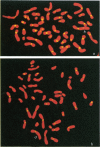Abstract
Application of a modified immunofluorescence technique using an anti-kinetochore serum enables cytogeneticists to obtain quality metaphase spreads and to localize kinetochores. In a patient with a 45, XX, -9, -11, tdic (9p;11p) constitution, we found that the dicentric marker chromosome has an intensely fluorescent kinetochore (no. 11), the functional centromere, and a less intensely fluorescent kinetochore (no. 9), the inactive centromere. The data suggest that in the process of tandem fusion (telomere-telomere between 11p and 9p), the centromere of chromosome 9 was not deleted, but, rather, inactivated.
Full text
PDF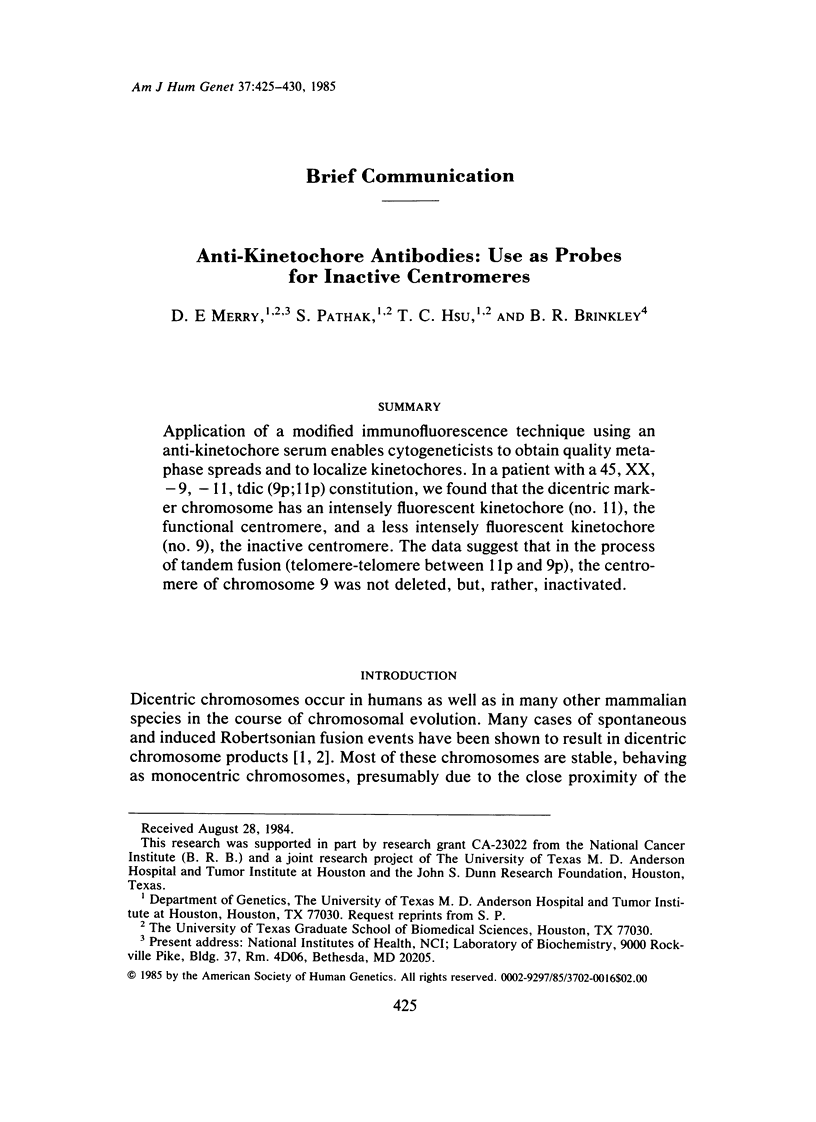
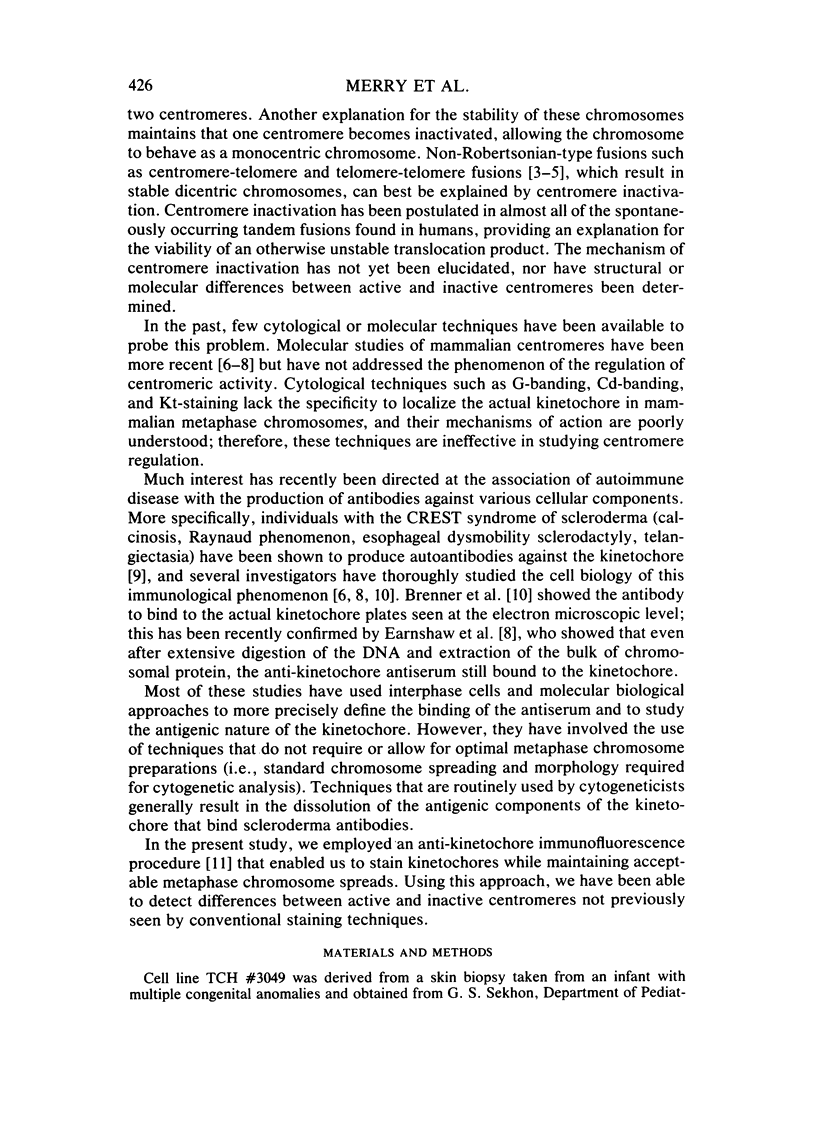
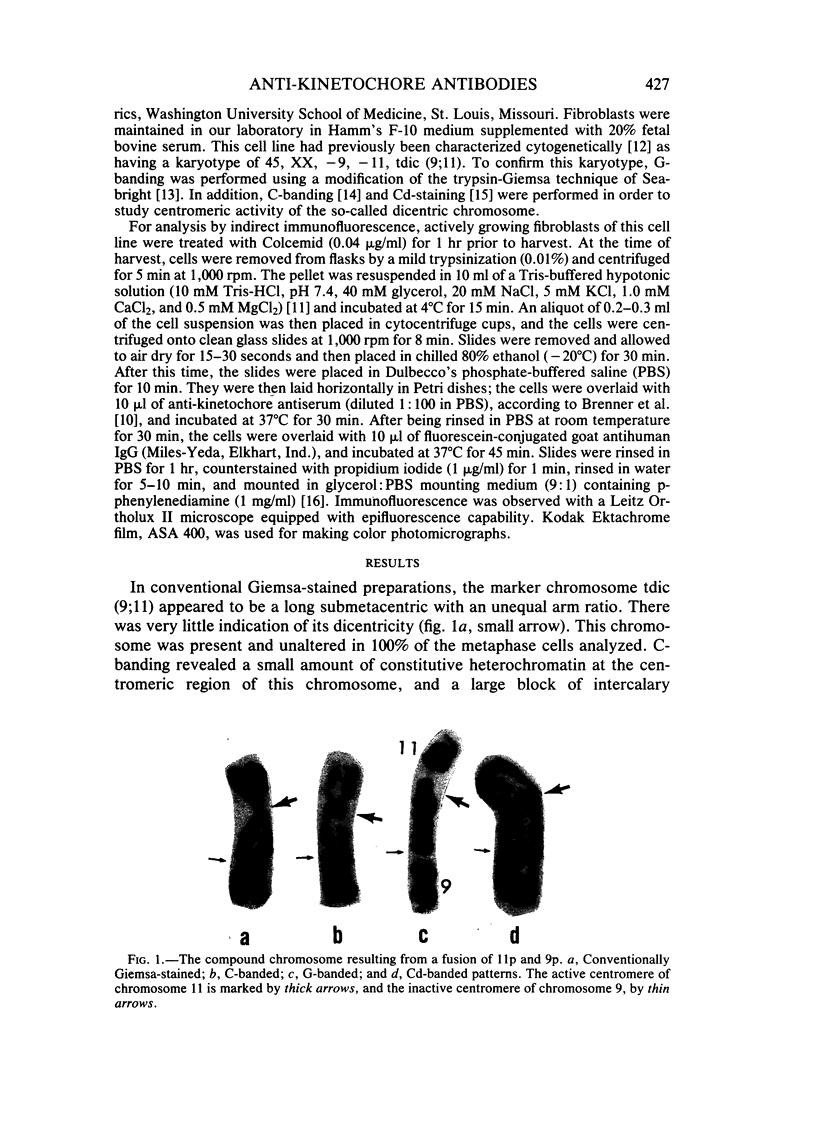
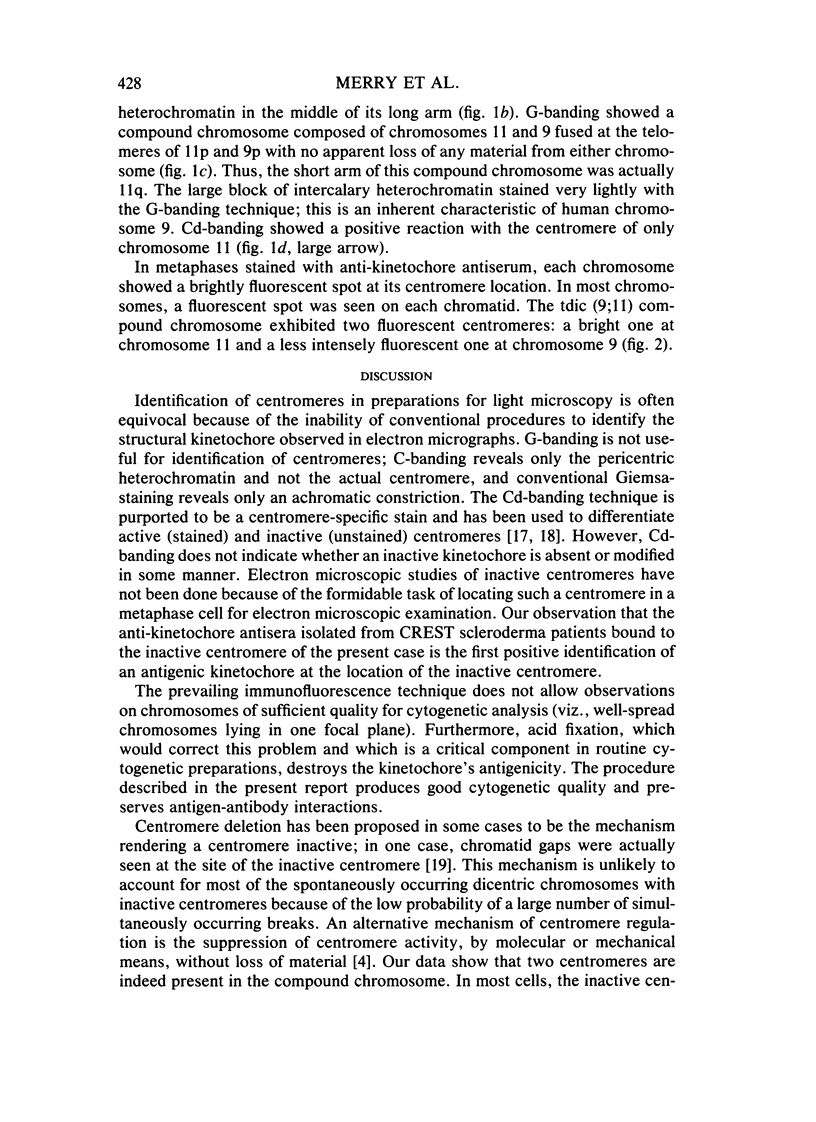
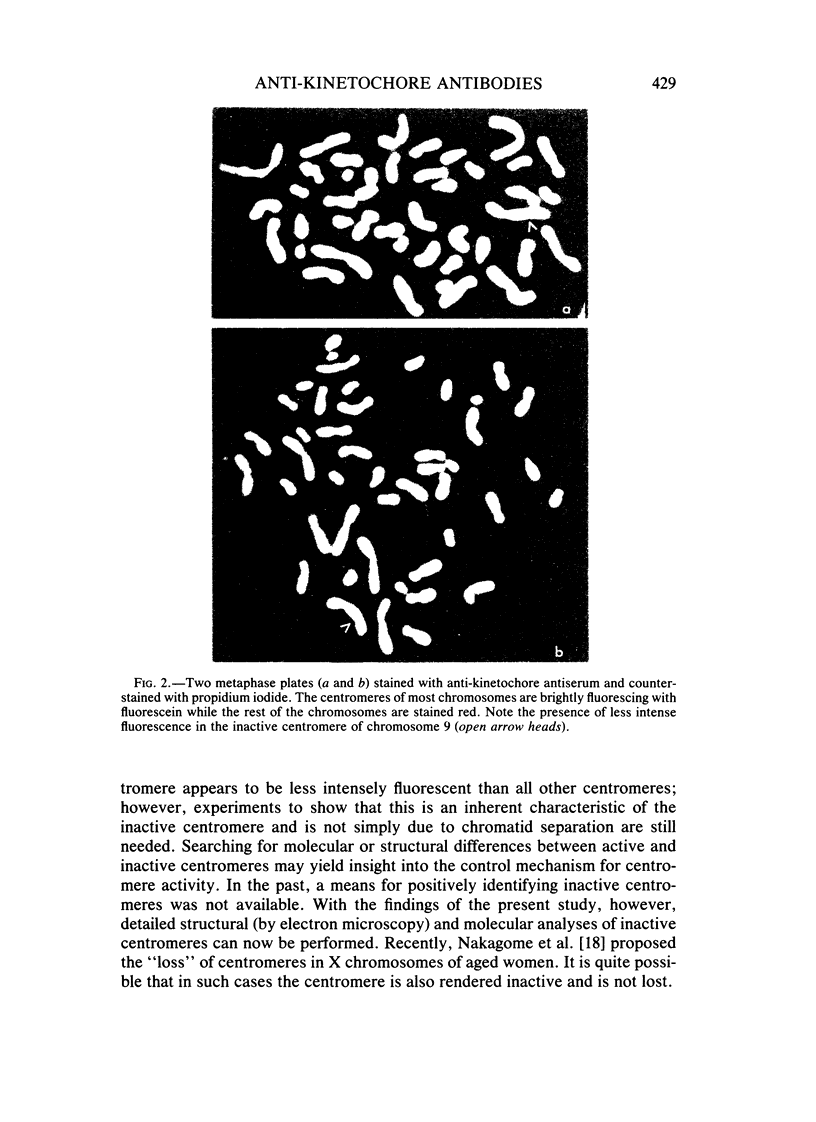
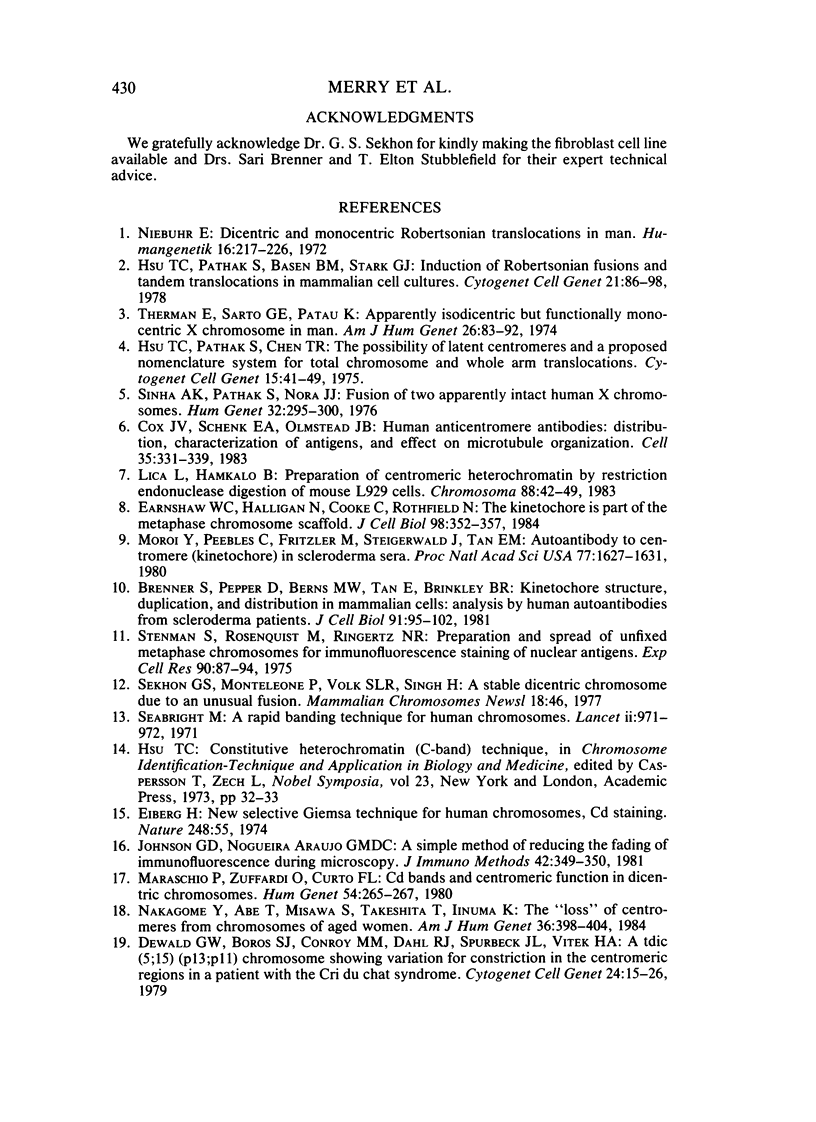
Images in this article
Selected References
These references are in PubMed. This may not be the complete list of references from this article.
- Brenner S., Pepper D., Berns M. W., Tan E., Brinkley B. R. Kinetochore structure, duplication, and distribution in mammalian cells: analysis by human autoantibodies from scleroderma patients. J Cell Biol. 1981 Oct;91(1):95–102. doi: 10.1083/jcb.91.1.95. [DOI] [PMC free article] [PubMed] [Google Scholar]
- Cox J. V., Schenk E. A., Olmsted J. B. Human anticentromere antibodies: distribution, characterization of antigens, and effect on microtubule organization. Cell. 1983 Nov;35(1):331–339. doi: 10.1016/0092-8674(83)90236-2. [DOI] [PubMed] [Google Scholar]
- Dewald G. W., Boros S. J., Conroy M. M., Dahl R. J., Spurbeck J. L., Vitek H. A. A tdic(5;15)(p31;p11) chromosome showing variation for constriction in the centromeric regions in a patient with the cri du chat syndrome. Cytogenet Cell Genet. 1979;24(1):15–26. doi: 10.1159/000131352. [DOI] [PubMed] [Google Scholar]
- Earnshaw W. C., Halligan N., Cooke C., Rothfield N. The kinetochore is part of the metaphase chromosome scaffold. J Cell Biol. 1984 Jan;98(1):352–357. doi: 10.1083/jcb.98.1.352. [DOI] [PMC free article] [PubMed] [Google Scholar]
- Eiberg H. New selective Giemsa technique for human chromosomes, Cd staining. Nature. 1974 Mar 1;248(5443):55–55. doi: 10.1038/248055a0. [DOI] [PubMed] [Google Scholar]
- Hsu T. C., Pathak S., Basen B. M., Stark G. J. Induced Robertsonian fusions and tandem translocations in mammalian cell cultures. Cytogenet Cell Genet. 1978;21(1-2):86–98. doi: 10.1159/000130881. [DOI] [PubMed] [Google Scholar]
- Hsu T. C., Pathak S., Chen T. R. The possibility of latent centromeres and a proposed nomenclature system for total chromosome and whole arm translocations. Cytogenet Cell Genet. 1975;15(1):41–49. doi: 10.1159/000130497. [DOI] [PubMed] [Google Scholar]
- Johnson G. D., Nogueira Araujo G. M. A simple method of reducing the fading of immunofluorescence during microscopy. J Immunol Methods. 1981;43(3):349–350. doi: 10.1016/0022-1759(81)90183-6. [DOI] [PubMed] [Google Scholar]
- Lica L., Hamkalo B. Preparation of centromeric heterochromatin by restriction endonuclease digestion of mouse L929 cells. Chromosoma. 1983;88(1):42–49. doi: 10.1007/BF00329502. [DOI] [PubMed] [Google Scholar]
- Maraschio P., Zuffardi O., Lo Curto F. Cd bands and centromeric function in dicentric chromosomes. Hum Genet. 1980;54(2):265–267. doi: 10.1007/BF00278982. [DOI] [PubMed] [Google Scholar]
- Moroi Y., Peebles C., Fritzler M. J., Steigerwald J., Tan E. M. Autoantibody to centromere (kinetochore) in scleroderma sera. Proc Natl Acad Sci U S A. 1980 Mar;77(3):1627–1631. doi: 10.1073/pnas.77.3.1627. [DOI] [PMC free article] [PubMed] [Google Scholar]
- Nakagome Y., Abe T., Misawa S., Takeshita T., Iinuma K. The "loss" of centromeres from chromosomes of aged women. Am J Hum Genet. 1984 Mar;36(2):398–404. [PMC free article] [PubMed] [Google Scholar]
- Niebuhr E. Dicentric and monocentric Robertsonian translocations in man. Humangenetik. 1972;16(3):217–226. doi: 10.1007/BF00273467. [DOI] [PubMed] [Google Scholar]
- Seabright M. A rapid banding technique for human chromosomes. Lancet. 1971 Oct 30;2(7731):971–972. doi: 10.1016/s0140-6736(71)90287-x. [DOI] [PubMed] [Google Scholar]
- Sinha A. K., Pathak S., Nora J. J. Fusion of two apparently intact human X chromosomes. Hum Genet. 1976 Jun 29;32(3):295–300. doi: 10.1007/BF00295819. [DOI] [PubMed] [Google Scholar]
- Stenman S., Rosenqvist M., Ringertz N. R. Preparation and spread of unfixed metaphase chromosomes for immunofluorescence staining of nuclear antigens. Exp Cell Res. 1975 Jan;90(1):87–94. doi: 10.1016/0014-4827(75)90360-2. [DOI] [PubMed] [Google Scholar]
- Therman E., Sarto G. E., Patau K. Apparently isodicentric but functionally monocentric X chromosome in man. Am J Hum Genet. 1974 Jan;26(1):83–92. [PMC free article] [PubMed] [Google Scholar]




